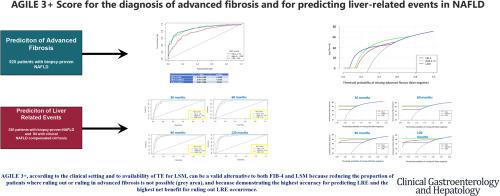Clinical Gastroenterology and Hepatology ( IF 11.6 ) Pub Date : 2022-07-14 , DOI: 10.1016/j.cgh.2022.06.013 Grazia Pennisi 1 , Marco Enea 1 , Alessandra Pandolfo 1 , Ciro Celsa 1 , Michela Antonucci 2 , Carlo Ciccioli 1 , Giuseppe Infantino 1 , Claudia La Mantia 1 , Stefanie Parisi 1 , Adele Tulone 1 , Vito Di Marco 1 , Antonio Craxì 1 , Calogero Cammà 1 , Salvatore Petta 1

|
Background & Aims
We aimed to assess the diagnostic accuracy of AGILE 3+, a recently developed score based on the combination of aspartate aminotransferase/alanine aminotransferase ratio, platelet count, diabetes status, sex, age, and liver stiffness measurement (LSM) by transient elastography, when compared with Fibrosis-4 (FIB-4) and LSM, for the diagnosis of advanced fibrosis and for the prediction of liver-related events (LREs) occurrence in patients with NAFLD.
Methods
A total of 614 consecutive patients with biopsy-proven NAFLD or clinical diagnosis of NAFLD-related compensated cirrhosis were enrolled. LREs were recorded during follow-up. FIB-4, LSM by transient elastography (FibroScan device), and AGILE 3+ were measured. The diagnostic performance of noninvasive criteria for advanced fibrosis and for the prediction of LREs was assessed using the area under the receiver operating characteristic curve (AUROC) and decision curve analysis.
Results
In patients with biopsy-proven NAFLD (n = 520), LSM and AGILE 3+ had higher AUROC than FIB-4 (0.88 for LSM and AGILE 3+ vs 0.78 for FIB-4; P < .001) for advanced fibrosis, and AGILE 3+ exhibited a smaller indeterminate area in the test (25.2% for FIB-4 vs 13.1% for LSM vs 8.3% for AGILE 3+). Within the entire cohort of patients, AGILE 3+ had significantly higher AUROC for predicting LREs with respect to LSM (AUROC 36 months 0.95 vs 0.93; P =.008; 60 months 0.95 vs 0.92; P = .006; 96 months 0.97 vs 0.95; P = .001). Decision curve analysis showed that all scores had modest net benefit for ruling-out advanced fibrosis at the risk threshold of 5% to 10% where advanced fibrosis was absent. At the risk threshold of 5% of false negatives or false positives in LRE at 36, 60, 96, and 120 months, AGILE 3+ outperformed both FIB-4 and LSM for ruling out LRE.
Conclusions
Depending on resource availability, clinical setting, and the risk scenarios, AGILE 3+ is an accurate and valid alternative to FIB-4 and LSM for the noninvasive assessment of disease severity and prognosis in patients with NAFLD.
中文翻译:

AGILE 3+ 评分用于诊断晚期纤维化和预测 NAFLD 中的肝脏相关事件
背景与目标
我们的目的是评估 AGILE 3+ 的诊断准确性,AGILE 3+ 是最近开发的评分,基于天冬氨酸氨基转移酶/丙氨酸氨基转移酶比率、血小板计数、糖尿病状态、性别、年龄和瞬时弹性成像法测量的肝脏硬度 (LSM) 的组合,当与 Fibrosis-4 (FIB-4) 和 LSM 相比,用于诊断 NAFLD 患者的晚期纤维化和预测肝脏相关事件 (LRE) 的发生。
方法
共有 614 名经活检证实为 NAFLD 或临床诊断为 NAFLD 相关代偿期肝硬化的连续患者入组。在随访期间记录了 LRE。测量了 FIB-4、瞬态弹性成像(FibroScan 设备)的 LSM 和 AGILE 3+。使用受试者工作特征曲线下面积 (AUROC) 和决策曲线分析评估了非侵入性标准对晚期纤维化和 LRE 预测的诊断性能。
结果
在经活检证实的 NAFLD (n = 520) 患者中, LSM 和 AGILE 3+ 对于晚期纤维化的 AUROC 高于 FIB-4(LSM 和 AGILE 3+ 为 0.88,FIB-4 为 0.78;P < .001),并且AGILE 3+ 在测试中表现出较小的不确定区域(FIB-4 为 25.2%,LSM 为 13.1%,AGILE 3+ 为 8.3%)。在整个患者队列中,AGILE 3+ 具有显着更高的 AUROC 预测 LRE 相对于 LSM(AUROC 36 个月 0.95 对 0.93;P =.008;60 个月 0.95 对 0.92;P =.006;96 个月 0.97 对 0.95 ; P =.001)。决策曲线分析表明,在 5% 至 10% 的风险阈值下,在不存在晚期纤维化的情况下,所有评分对于排除晚期纤维化都有适度的净收益。在 36、60、96 和 120 个月时,在 LRE 中 5% 的假阴性或假阳性风险阈值下,AGILE 3+ 在排除 LRE 方面优于 FIB-4 和 LSM。
结论
根据资源可用性、临床环境和风险情景,AGILE 3+ 是 FIB-4 和 LSM 的准确有效替代方法,用于无创评估 NAFLD 患者的疾病严重程度和预后。











































 京公网安备 11010802027423号
京公网安备 11010802027423号